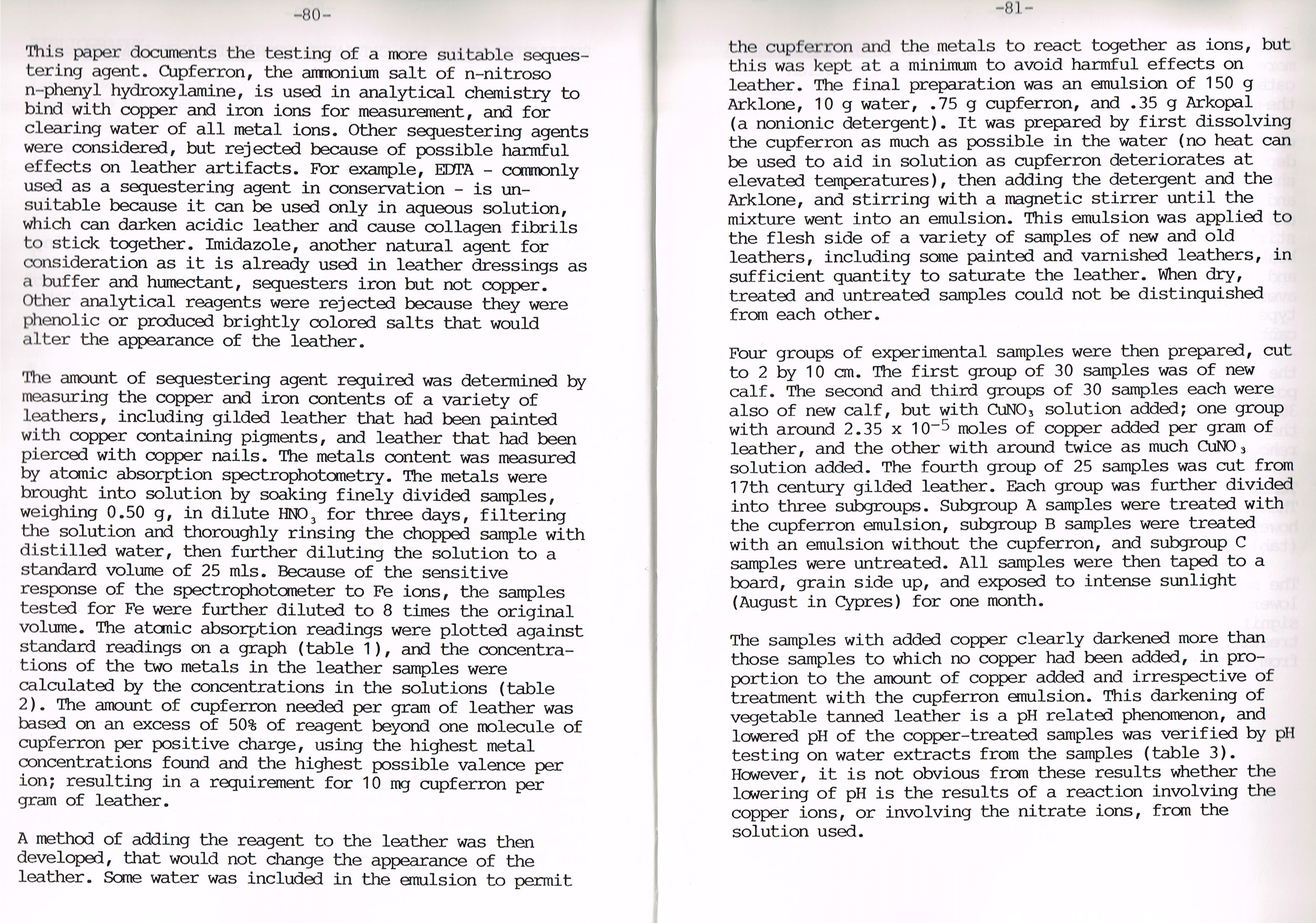CCI20140507�43

-80-
This paper documents the testing of a morę suitable seques-tering agent. Cupferron, the ammonium salt of n-nitroso n-phenyl hydroxylaminę, is used in analytical chemistry to bind with copper and iron ions for measurement, and for clearing water of all metal ions. Other seguestering agents were considered, but rejected because of possible harmful effects on leather artifacts. For example, EETA - canmonly used as a sequestering agent in conservation - is un-suitable because it can be used only in aąueous solution, which can darken acidic leather and cause collagen fibrils to stick together. Imidazole, another natural agent for consideration as it is already used in leather dressings as a buffer and humectant, seąuesters iron but not copper. Other analytical reagents were rejected because they were phenolic or produced brightly colored salts that would alter the appearance of the leather.
The amount of seąuestering agent reąuired was determined by measuring the copper and iron contents of a variety of leathers, including gilded leather that had been painted with copper containing pigments, and leather that had been pierced with copper nails. The metals content was measured by atomie absorption spectrophotometry. The metals were brought into solution by soaking finely divided samples, weighing 0.50 g, in dilute HN03 for three days, filtering the solution and thoroughly rinsing the chopped sample with distilled water, then further diluting the solution to a standard volume of 25 mis. Because of the sensitive response of the spectrophotometer to Fe ions, the samples tested for Fe were further diluted to 8 times the original volume. The atomie absorption readings were plotted against standard readings on a graph (table 1), and the concentra-tions of the two metals in the leather samples were calculated by the concentrations in the Solutions (table 2). The amount of cupferron needed per gram of leather was based on an excess of 50% of reagent beyond one molecule of cupferron per positive charge, using the highest metal concentrations found and the highest possible valence per ion; resulting in a reąuirement for 10 mg cupferron per gram of leather.
A method of adding the reagent to the leather was then developed, that would not change the appearance of the leather. Sanę water was included in the emulsion to permit
the cupferron and the metals to react together as ions, but this was kept at a minimum to avoid harmful effects on leather. The finał preparation was an emulsion of 150 g Arklone, 10 g water, .75 g cupferron, and .35 g Arkopal (a nonionic detergent). It was prepared by first dissolving the cupferron as much as possible in the water (no heat can be used to aid in solution as cupferron deteriorates at elevated temperatures), then adding the detergent and the Arklone, and stirring with a magnetic stirrer until the mixture went into an emulsion. This emulsion was applied to the flesh side of a variety of samples of new and old leathers, including some painted and vamished leathers, in sufficient quantity to saturate the leather. When dry, treated and untreated samples could not be distinąuished from each other.
Four groups of experimental samples were then prepared, cut to 2 by 10 cm. The first group of 30 samples was of new calf. The second and third groups of 30 samples each were also of new calf, but with CuNOj solution added; one group with around 2.35 x 10-5 moles of copper added per gram of leather, and the other with around twice as much CuNO 3 solution added. The fourth group of 25 samples was cut from 17th century gilded leather. Each group was further divided into three subgroups. Subgroup A samples were treated with the cupferron emulsion, subgroup B samples were treated with an emulsion without the cupferron, and subgroup C samples were untreated. Ali samples were then taped to a board, grain side up, and exposed to intense sunlight (August in Cypres) for one month.
The samples with added copper clearly darkened morę than those samples to which no copper had been added, in pro-portion to the amount of copper added and irrespective of treatment with the cupferron emulsion. This darkening of vegetable tanned leather is a pH related phenomenon, and lowered pH of the copper-treated samples was verified by pH testing on water extracts from the samples (table 3). However, it is not obvious from these results whether the lcwering of pH is the results of a reaction involving the copper ions, or involving the nitratę ions, from the solution used.
Wyszukiwarka
Podobne podstrony:
00344 ?901c63c87335b6f7bf31c8dbbac4a5 348 Prairie & Zimmer ąuality. The purpose of the plans pr
292 TRIBOLOGIA 4-2010 Summary This paper describes the construction of a tribological device in
00339 +06a963b1e1eb1e683a249968625de1 342 McCarville & Montgomery Additionał Considerations The
CCI20121023�16 Stylistyka XVIIIAdministrative Polish and its Variants The aim of this paper is to ma
00215 ?0e621dbf006c49e21a7837633685a1 217 Applications of the EWMA This paper (1) describes a metho
Effect Of Dividends On Stock Prices 12 4. Research Methodology This paper has used the Panel data ap
ds91 Thanx for downloading this paper model of "Deep Space Ninę" (or "Terok Nor"
10404397R3050797823525?5148902141299776 n The subject of this paper, namely stress, strain, strass-s
Mining and Em ironment In this paper the regional model of emironmental management system is present
Dean s Message Dear students, the fact that you are browsing the pages of this document is reflectiv
DSC07886 (3) 4. AGE OF THE PLENIV1STUL1AN DUNES; DUNE-FORMING PHASES In the light of the investigati
michałek TapescriptsIa Listeningexercise3 ## 1.1 My choice for Pick of the Week this week is the BBC
ZOFIA KACZOROWSKA PRECIPITATION IN POLAND IN LONG-PERIOD AVERAGES Summary In the first part of this
44 M. SIKORSKI ABSTRACT The aim of this paper is to review the most widely used techniąue for studie
The role of accounting in an anti-crisis prevention in smali businesses Summary: The purpose of this
więcej podobnych podstron